

The 2025 State of AI Readiness in FAIR Customer Companies: The Case of Finland
Dr Umair Ali Khan, 25.8.2025
Despite widespread enthusiasm for artificial intelligence adoption, most companies remain trapped in the early stages of AI readiness, unable to translate promising concepts into functional business solutions. Analysis of consultancy data from 110 organizations across Finland and Sweden reveals that technical expertise gaps, insufficient data management capabilities, and lack of strategic planning continue to hinder meaningful AI integration in 2025.


Our AI consultancy, through the Finnish AI Region (FAIR) project, has been helping companies transform AI concepts into practical business solutions. We assist organizations with AI roadmap planning, proof-of-concept development, business value assessment, application development, solution reviews, and data management strategies.
To date, over 110 companies have participated in our consultancy services, with 85% based in Finland and 15% from Sweden and other countries. Earlier this year, we launched a proof-of-concept service at Haaga-Helia University of Applied Sciences. This addition came from recognizing that many companies had promising AI ideas but lacked the technical expertise to build functional prototypes that could demonstrate real business value.
Each consultancy produces a detailed report that evaluates the company’s AI readiness, the technical feasibility of proposed solutions, data requirements, and organizational maturity. These reports include specific recommendations and actionable next steps.
Companies can then schedule follow-up advisory sessions based on their needs and progress. We have also been publishing our insights on the AI consultancy, AI adoption trends, and the major challenges (Khan, 2025a; Khan et al., 2025).
This article examines findings from our recent analysis of the AI consultancy data, revealing the current state of AI adoption among FAIR customer companies and the key obstacles in AI integration.
Knowledge Extraction
Our AI consultancy reports contain rich information in unstructured text format. To analyze trends and patterns across multiple reports, we needed to extract key insights and organize them into structured data.
We recently developed a generic knowledge extraction AI application that simplifies this process. Instead of building custom extraction systems for each use case, our tool allows users to define what information they need using plain language descriptions. The agent then automatically identifies and extracts the relevant data points from the documents. The initial version of this tool is available as open-source software (Khan, 2025b).
We are currently expanding the tool’s capabilities to handle different document formats and data sources. This knowledge extraction application is one of the modular components or services of a broader generative AI toolkit we are building in the Generative AI Enhanced Knowledge Management in Business (GAIK) project (HHUAS, 2025), funded by the European Regional Development Fund (ERDF). The toolkit consists of modular components and services that companies can use to develop their own AI use cases.
Overall Picture
The majority of participating companies are based in Finland, with the remaining from other Nordic countries, primarily Sweden. The company composition shows an interesting balance between established businesses and startups.
Established companies often seek to integrate AI into existing operations and processes, while startups usually build AI capabilities into their core business models from the outset.
One of the most significant findings relates to organizational AI readiness. A large proportion of companies demonstrates low AI maturity levels, meaning they are in the early stages of understanding and implementing AI solutions.
This suggests that the majority of companies need foundational support in developing AI strategies, understanding data requirements, and building internal capabilities before they can successfully implement complex AI solutions.
Generative AI has become the main focus of interest. This reflects the significant attention generative AI has received following technological breakthroughs. Companies are exploring applications ranging from content generation and customer service automation to code development and data analysis. Healthcare stands out as the leading sector engaging with AI consultancy services. This concentration in healthcare reflects both the sector’s data-rich environment and the potential for AI to address critical challenges in patient care, diagnostics, and operational efficiency.
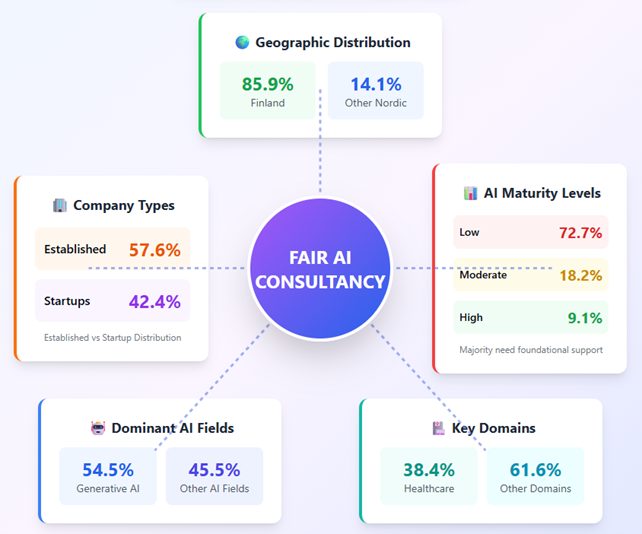
AI Maturity Distribution by Company Type
We categorize companies into three AI maturity levels (AIMLs). Low maturity companies are in early ideation phases with limited data, resources, and AI expertise, minimal workflow integration, and no formal AI roadmap.
Moderate maturity companies have moved beyond proof-of-concept stages with functional solutions, adequate resources, and developing data management processes guided by partially formed AI strategies. High maturity companies have developed advanced AI products with established customer bases, fully integrated workflows, established data management processes, and comprehensive AI roadmaps.
While both startups and established companies show predominantly low AI maturity levels, startups have recently begun to demonstrate a slightly more advanced distribution overall. This suggests that newer companies are better positioned to integrate AI from their early stages of development. Startups also show higher representation in the moderate maturity level compared to established companies.
Though the majority of companies, including both startups and established companies, lack high AIMLs, the findings indicate that startups are preparing for AI adoption from the beginning of their business development, often incorporating AI considerations into their initial business models and operational planning. In contrast, established companies face the additional challenge of integrating AI into existing systems, processes, and organizational cultures that were not originally designed with AI capabilities in mind.
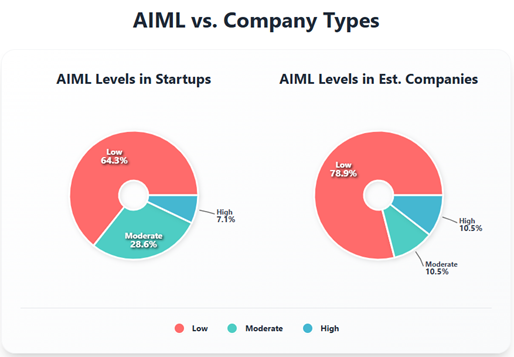
Technical Expertise as a Driver of AI Maturity
The relationship between technical expertise and AI maturity reveals a clear pattern that highlights the importance of in-house capabilities for successful AI implementation. Companies that have reached high AI maturity levels usually have moderate to high technical/AI expertise. In contrast, companies with low AI maturity are found to have low technical/AI expertise.
This distribution explains why these companies remain in early ideation phases or struggle to move beyond proof-of-concept stages. Without sufficient technical knowledge, teams cannot effectively evaluate AI feasibility, implement solutions, or troubleshoot complex technical challenges that arise during development.
This correlation between technical expertise and AI maturity suggests that companies seeking to advance their AI capabilities must prioritize building internal technical competencies through hiring, training, or strategic partnerships. Companies cannot simply purchase AI solutions and expect success without the technical foundation necessary to understand, implement, and maintain these systems effectively.
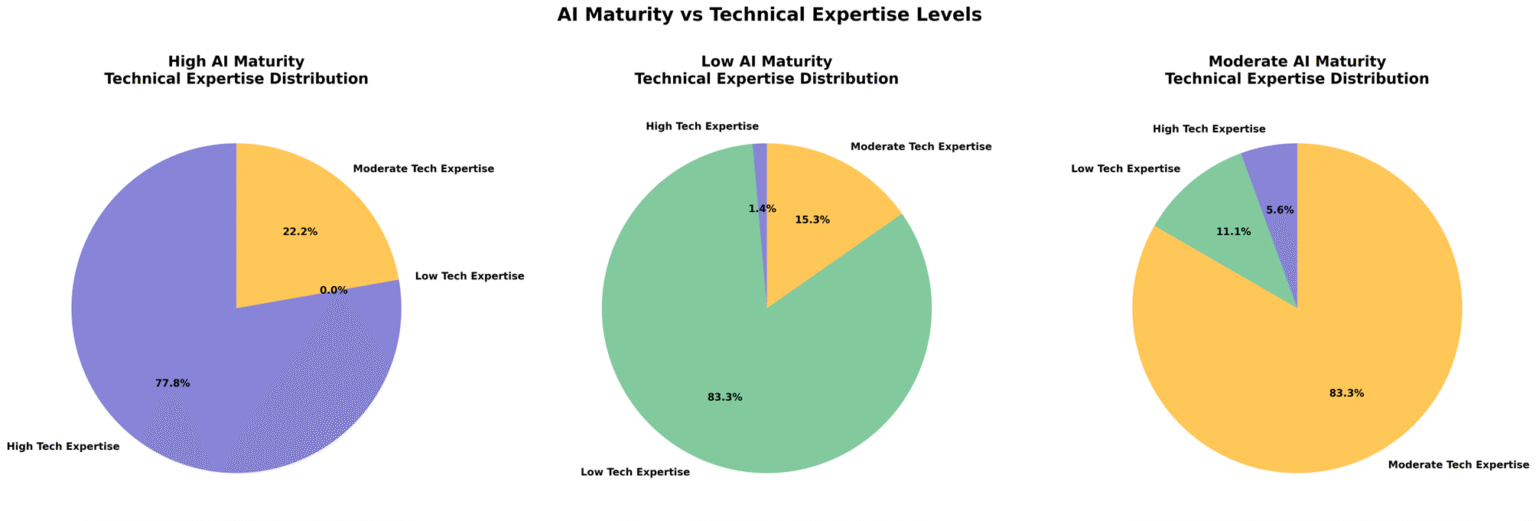
Technical Expertise Distribution Across Company Types
Startups show a notably higher concentration of moderate and high technical expertise compared to their established counterparts, which directly correlates with their relatively stronger AI maturity performance.
Startups show a more balanced technical expertise profile, with a substantial portion of their workforce possessing moderate technical skills and a smaller but meaningful representation of high expertise personnel. This distribution suggests that newer companies are building teams with the technical capabilities necessary for AI implementation from their founding stages.
Many startups today are formed by technically skilled founders who understand the importance of AI and data science capabilities. This leads them to prioritize hiring individuals with relevant expertise early in their development.
In contrast, established companies show a much heavier concentration in the low technical expertise category, with smaller proportions of moderate and high expertise personnel. This pattern reflects the historical hiring practices of companies that were founded before AI became a critical business capability. These companies built their teams around their core business functions, which may not have required advanced technical skills related to AI, machine learning, or data science.
The higher proportion of combined moderate and high technical expertise in startups explains their relatively better AI maturity levels compared to established companies. Startups can move more quickly through the ideation and proof-of-concept phases because their teams already possess the technical understanding needed to evaluate AI feasibility and implement solutions.
Established companies face the additional challenge of either retraining existing employees or recruiting new talent with AI expertise while managing their current operations. Even if some established companies do have high technical expertise, they often face the problem of adapting AI solutions to complex existing systems and processes, which can slow down the overall AI adoption timeline compared to startups building AI capabilities into their operations from the beginning.
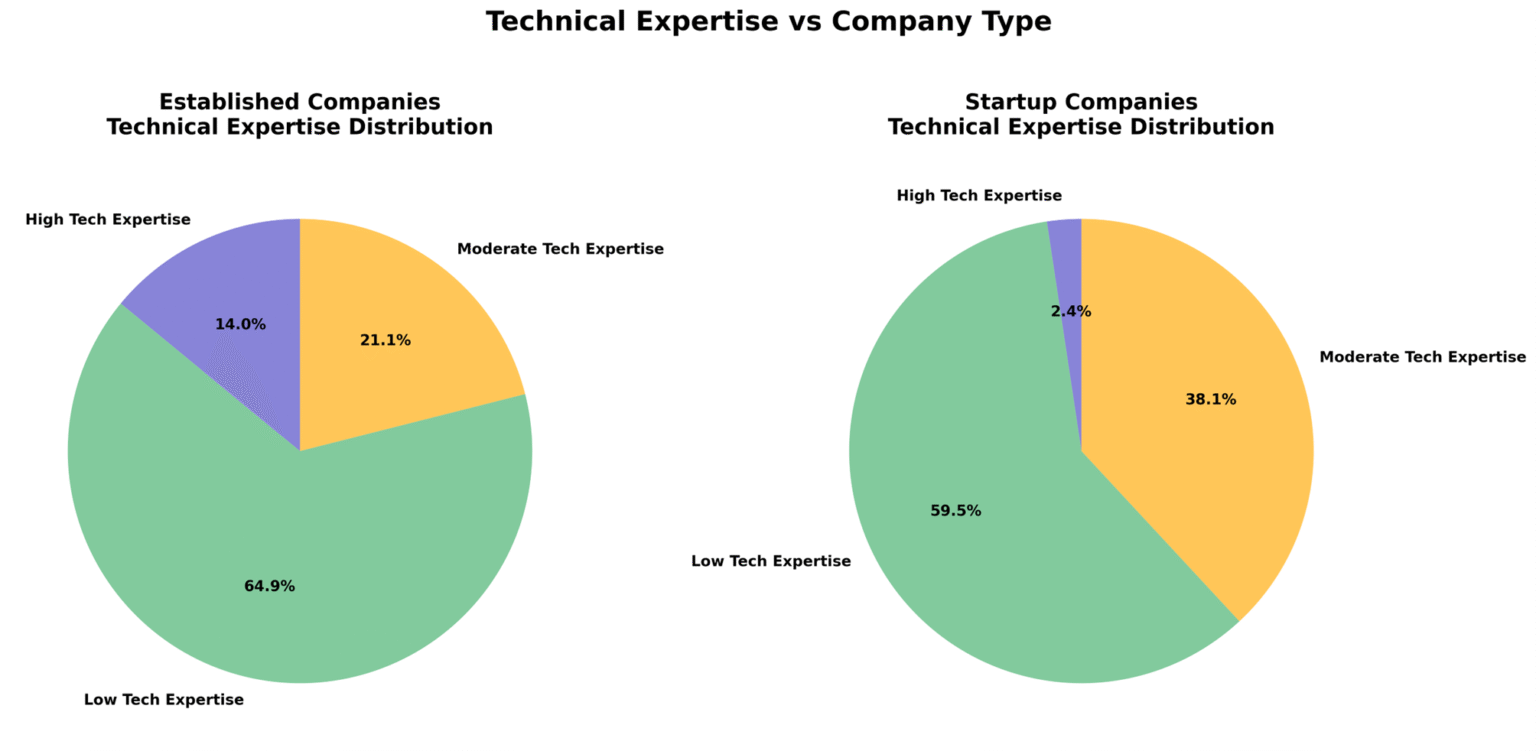
AI Technology Preferences and Application Areas
Generative AI dominates the landscape by a significant margin, representing more than half of all AI-related projects. This preference reflects the practical accessibility and immediate business value that companies perceive in generative AI applications.
The popularity of generative AI can be attributed to several factors that make it particularly attractive to businesses across different sectors. Large language models and AI agents offer immediate applications in customer service, content creation, document processing, and workflow automation without requiring extensive technical infrastructure or specialized datasets. Companies can often implement generative AI solutions relatively quickly compared to other AI technologies.
Computer vision and image processing also indicate a strong interest in visual AI applications. This field is attracting companies in the domain of healthcare & wellbeing, manufacturing, transport & logistics, defence, security, construction, arts and entertainment, and others. The availability of pre-trained models and the growing capabilities of LLMs for vision tasks have made computer vision more accessible to businesses that previously lacked the technical expertise to implement such solutions.
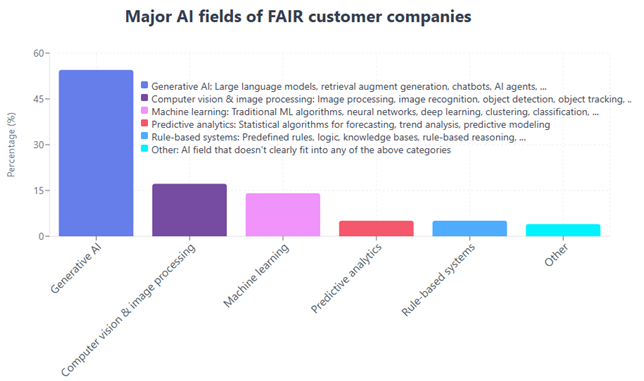
Traditional machine learning maintains a solid presence, representing companies focused on data-driven decision making, pattern recognition, and algorithmic optimization. These companies typically have established data collection processes and seek to extract insights from historical information to improve operations or predict future trends.
Industry Distribution and Sector-Specific AI Adoption
The industry distribution among FAIR customer companies reveals patterns of AI adoption across different sectors. Healthcare and wellbeing emerges as the clear leader, representing nearly two-fifths of all FAIR customer companies.
Healthcare organizations are particularly drawn to AI solutions because of their data-rich environments and the potential for significant impact on patient outcomes and operational efficiency. Medical institutions generate vast amounts of structured an d unstructured data through patient records, diagnostic imaging, treatment protocols, and administrative processes.
AI applications in this sector include diagnostic assistance, customer service improvements, patient queue reduction, lifestyle and activity data analysis from wearable devices, root cause detection for functional medicine, personalized healthcare recommendations, sentiment analysis of patient comments, and early detection of dementia and Alzheimer’s disease, among others.
Besides healthcare professionals, healthcare-related startups and established companies offering healthcare and wellbeing services are also drawn to adopting AI.
Companies focusing on business enhancement target survey data analysis, job-seeker and recruiter matchmaking, skill development, onboarding, and customer experience improvement. The strong representation of business enhancement applications indicates that many companies are taking a pragmatic approach to AI adoption, focusing on areas where they can achieve measurable improvements in existing operations.
Education and training reflect growing interest in AI-powered learning solutions and educational technology. The targeted applications and ideas include assistance for research ideation, skill mapping, content generation from educational videos, personalized learning, tailored educational content generation, peer matching, and language learning, among others.
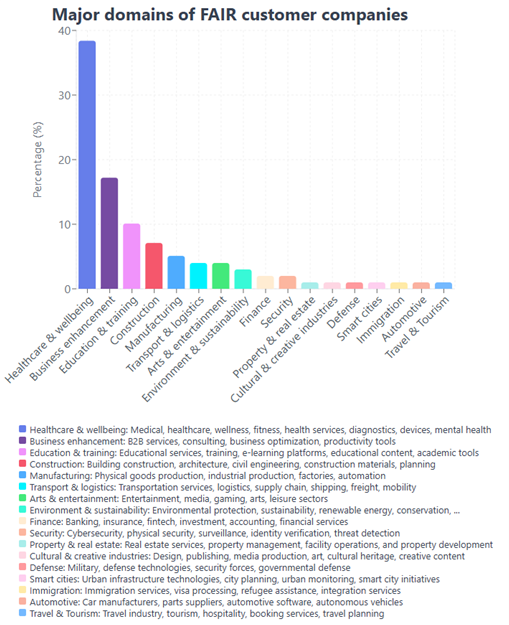
Data Requirements and Information Assets
The data requirements analysis reveals insights about the types of information assets that companies need for their AI initiatives. Text data represents the most recurring type that aligns with the earlier finding that generative AI is the most popular technology field, as text-based AI applications require substantial amounts of written content for training and operation.
The high usage of and demand for text data reflects the widespread interest in applications such as document processing, customer service automation, content generation, and knowledge management systems.
Companies across various sectors possess large volumes of text data in forms ranging from customer communications and internal documents to regulatory filings and technical specifications.
While the extraction of structured data from unstructured documents has shown increasing interest from businesses, many businesses either have/produce structured data or need structured data.
Examples of structured data include sensor signals from IoT devices, survey data, patient records, geo-spatial data, and financial data, among others.
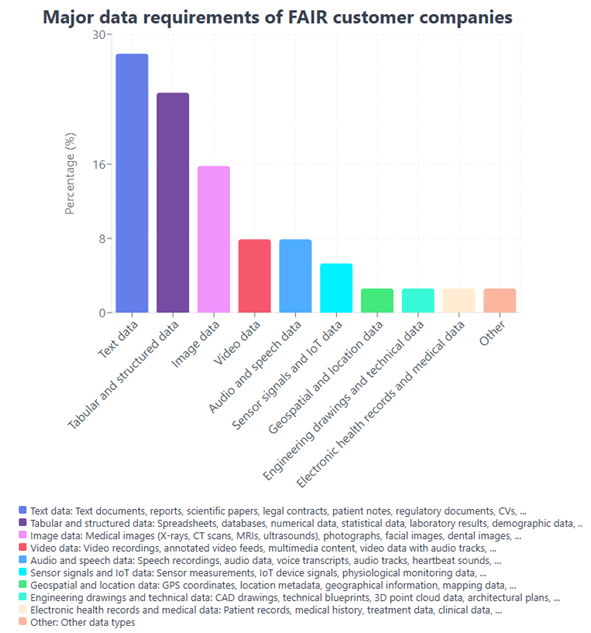
Image data also reflects the significant interest in computer vision applications identified earlier in this article. Applications of image data include healthcare diagnostics for early detection of diseases, virtual tours in industrial settings for onboarding and automatic quotation generation from manufacturing diagrams/schematics, powerline inspection using drones, segmenting objects from 3D point cloud data, and information model generation from architectural drawings, among others.
Service Demands and Support Requirements
The analysis of services sought by FAIR customer companies reveals a clear pattern that directly reflects the technical expertise gaps identified earlier in this analysis.
Technical advice dominates the service landscape, representing nearly half of all requests, which demonstrates that most companies lack the fundamental expertise needed to navigate AI implementation decisions. Companies seeking technical advice need guidance on algorithmic design, model selection, training methodologies, testing protocols, and deployment strategies, as they lack the expertise to make these critical decisions independently.
Proof-of-concept development emerges as the second most requested service, highlighting companies’ inability to build functional prototypes that could validate their AI ideas.
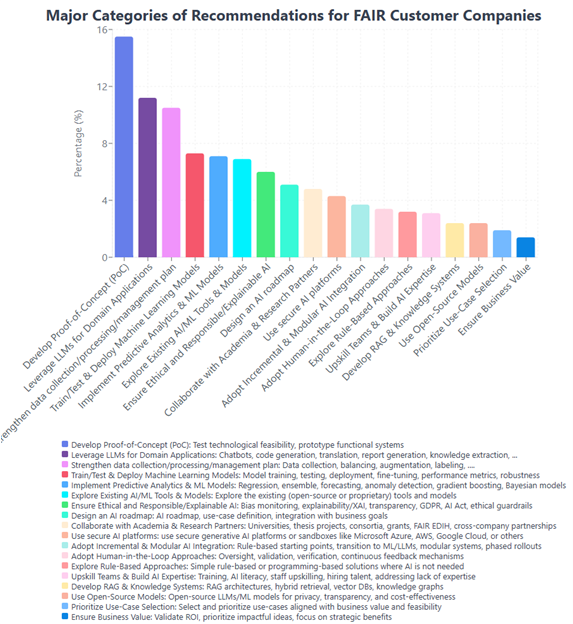
Companies requesting this service have identified potential applications but lack the technical skills to create working demonstrations that prove feasibility and demonstrate value.
The lack of a concrete AI roadmap also reflects companies’ struggle to develop coherent, long-term AI strategies. Companies seeking AI roadmap assistance recognize the need for systematic planning but lack the knowledge to create realistic timelines, identify appropriate technologies, or sequence implementation phases effectively. This demand indicates that companies cannot independently assess their AI readiness, prioritize use cases, or design sustainable adoption pathways.
Recommendations and Strategic Guidance
Proof-of-concept development emerges as the most frequent recommendation, reflecting companies’ need for a deeper understanding of technical feasibility and their inability to develop prototypes independently.
Companies often have promising AI ideas but lack the technical capabilities to build functional demonstrations that validate their concepts. This recommendation addresses the critical gap between theoretical understanding and practical implementation, providing companies with tangible evidence of what AI can achieve for their specific use cases.
Recommendations to leverage large language models for domain applications align with the growing trend toward generative AI adoption. Due to their increasing capabilities and versatility, LLMs are being recommended for diverse tasks, including chatbot development, code generation, document translation, report creation, and knowledge extraction. These recommendations capitalize on the accessibility and immediate applicability of generative AI technologies for business operations.
Data collection, processing, and management recommendations address one of the most persistent challenges facing companies across all maturity levels. Companies consistently struggle not only with identifying the appropriate data types for their AI initiatives but also with collecting high-quality, relevant datasets. Many companies lack systematic approaches to data collection, cleaning, augmentation, and labeling processes that are essential for successful AI implementation.
The training and deployment of machine learning models represents another significant recommendation category, focusing on selecting, training, testing, and deploying the right AI/ML model and evaluating its performance. These recommendations address the technical complexity of model development that prevents many companies from moving beyond conceptual planning phases.
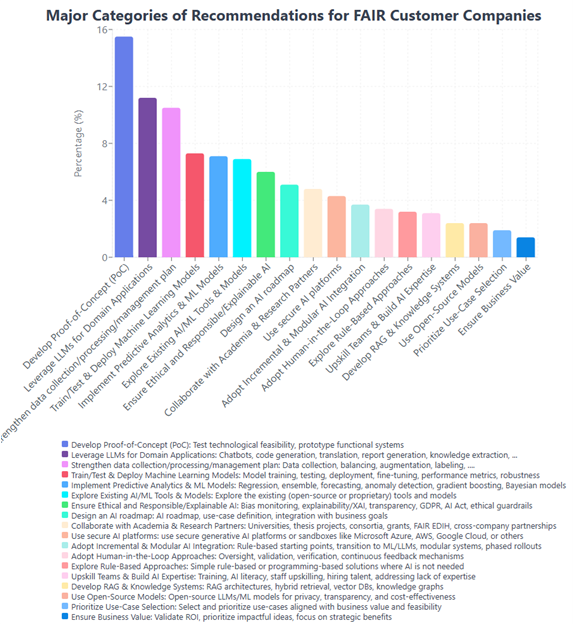
Predictive analytics recommendations target companies seeking to analyze data for forecasting and personalized services — for example, those working with sensor data from wearable devices or similar monitoring systems. These recommendations focus on regression algorithms, ensemble methods, anomaly detection techniques, and Bayesian modeling approaches that can extract actionable insights from temporal datasets.
Exploration of existing AI tools and models represents a pragmatic approach recommended to companies lacking resources for custom development. Rather than building solutions from scratch, companies are often guided toward pre-trained models, open-source frameworks, and established platforms that can address their needs more efficiently.
Ethical and responsible AI recommendations emphasize the importance of bias monitoring, explainability, transparency, and human oversight in AI implementations. These recommendations promote human-in-the-loop approaches that maintain appropriate control and validation mechanisms while ensuring AI outputs meet ethical standards and regulatory requirements.
The other recommendations address broader strategic needs, including AI roadmap development, academic partnerships for research collaboration, secure platform adoption for data privacy, incremental implementation approaches, team upskilling initiatives, and business value validation to ensure AI investments align with organizational objectives.
Key Obstacles in AI Adoption
The analysis of FAIR consultancy data uncovers several recurring challenges in implementing AI solutions.
- Limited technical expertise: The majority of companies lack the specialized knowledge required for AI development, model selection, and implementation, creating dependency on external consultants for basic technical decisions.
- Insufficient AI maturity: Nearly three-quarters of companies demonstrate low AI readiness, indicating inadequate foundational understanding of AI capabilities, requirements, and implementation processes.
- Data collection and management challenges: Companies struggle to identify appropriate data types, collect high-quality datasets, and establish proper data processing workflows essential for AI model training and deployment.
- Inability to build prototypes: Most companies cannot independently develop a proof-of-concept to validate AI ideas and assess technical feasibility before committing to full implementations.
- Lack of strategic planning: Companies require external assistance to design coherent AI roadmaps, prioritize use cases, and develop systematic approaches to AI adoption rather than pursuing ad hoc initiatives.
- Gap between concept and implementation: While businesses understand AI’s potential benefits, they cannot translate theoretical knowledge into practical applications without substantial external support.
- Ethical and compliance concerns: Companies struggle to address responsible AI practices and regulatory compliance requirements without expert guidance on implementation frameworks.
- Integration complexity: Established companies face additional challenges in incorporating AI into existing systems and workflows that were not designed with AI capabilities in mind.
These findings suggest that successful AI adoption requires sustained support for building internal capabilities alongside immediate technical assistance. Organizations benefit most from approaches that combine expert guidance with systematic skill development, enabling them to progress from external dependency toward self-sufficient AI implementation over time.
Contact

Dr. Umair Ali Khan
Senior Researcher
Haaga-Helia University of Applied Sciences
+358 29 447 1413
umairali.khan@haaga-helia.fi
References
Khan, U. A. (2025a). Analysis: AI adoption trends in FAIR customer companies. Finnish AI Region (FAIR). https://www.fairedih.fi/en/2025/02/19/ai-adoption-trends-in-fair-customer-companies/
Khan, U. A., Kauttonen, J., & Kudryavtsev, D. (2025). AI Adoption in Finnish SMEs: Key Findings from AI Consultancy at a European Digital Innovation Hub. IEEE. https://urn.fi/URN:NBN:fi-fe2025040423803
Khan, U. A. (2025b). Knowledge Extraction AI Agent [Source code]. GitHub. https://github.com/umairalipathan1980/A-Generic-Knowledge-Extraction-AI-Agent/tree/main
HHUAS. GAIK. (2025). Generative AI-Enhanced Knowledge Management in Business (GAIK). https://www.haaga-helia.fi/en/rdi-projects/gaik

Finnish AI Region
2022-2025.
Media contacts